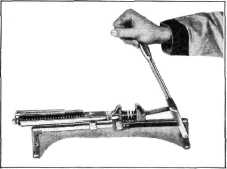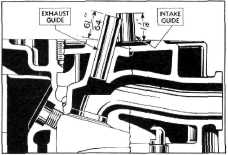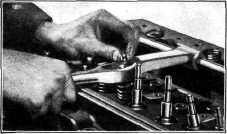1942 - 1947 CHEVROLET SHOP MANUAL
Section 6 - Engine
|
|
|||
|
6-23 |
|||
|
|
|||
|
The
clearances that must be maintained between the intake valve stem and guide is
.001" to .003", and the
clearance between the exhaust valve stem and guide is .002" to
.004".
Quite
naturally, if the valve guides are worn they should be replaced. To remove them
from the cylinder head, the
driver shown in Fig. 47 must be used. Place the cylinder head in an arbor
press and press the guide from
it using this tool.
The valve
guides do not have a shoulder to determine the distance they should be pressed
into the cylinder head. The intake guides should extend above the cylinder head 1-1/16" while the
exhaust guides extend above
the head 61/64". These dimensions are very important, Fig.
48.
To simplify
this operation and make sure the valve guides are pressed in the proper
distance, two valve guide
drivers are available. These drivers contain stop collars to
automatically stop the guides at the proper height.
After the
guides have been pressed into the cylinder head, they should be rough
reamed with a .341" reamer and then
finish reamed with a .343"
reamer. |
 |
||
|
Fig. 49—Valve Spring Tension Gauge
of an engine are reconditioned or
ground, the valve springs should be checked to be sure they have not been weakened from the heat of the engine.
This can easily be done by placing the valve spring in the valve
tester, U15, Fig. 49. and compressing it to a length of 1-1/2". At this length
the spring tension should be from 125 to 133 pounds. Springs that
do not test within these limits
should be replaced with new
genuine Chevrolet valve springs. |
|||
|
|
|||
 |
 |
||
|
|
|||
|
Fig. 48—Valve Guides
Valves and valve guides used on
the 1942 engines are interchangeable
with those on 1941 engines BUT
NOT WITH ANY MODELS PRIOR TO 1941.
VALVE SPRINGS, CAPS AND COVERS
Genuine
Chevrolet valve springs are made from a special analysis steel wire. They are
accurately coiled, and, after
being made, each spring is checked to insure that it is within the-
limits for tension. Springs
that fail to pass this inspection are immediately
scrapped.
Weak valve
springs affect the economy and power
of the engine; therefore, each time the
valves |
Fig. 50—Valve Spring Compressor
Each valve
spring is retained to the valve with a
cap and key. It is necessary to compress the spring with the spring compressor. Fig. 50,
which is a part of the cylinder
head holding fixture, far enough to allow the keys to be inserted
around the valve
stem.
The valve springs are assembled
with the close coiled end against the
cylinder head.
NOTE—Due to the difference in
the recess depth, the round valve spring caps must be installed on
the intake valves and the hexagonal caps on the exhaust valves. The intake
valve spring cap covers must be installed on the ends of all intake valve
stems. |
||
|
|
|||